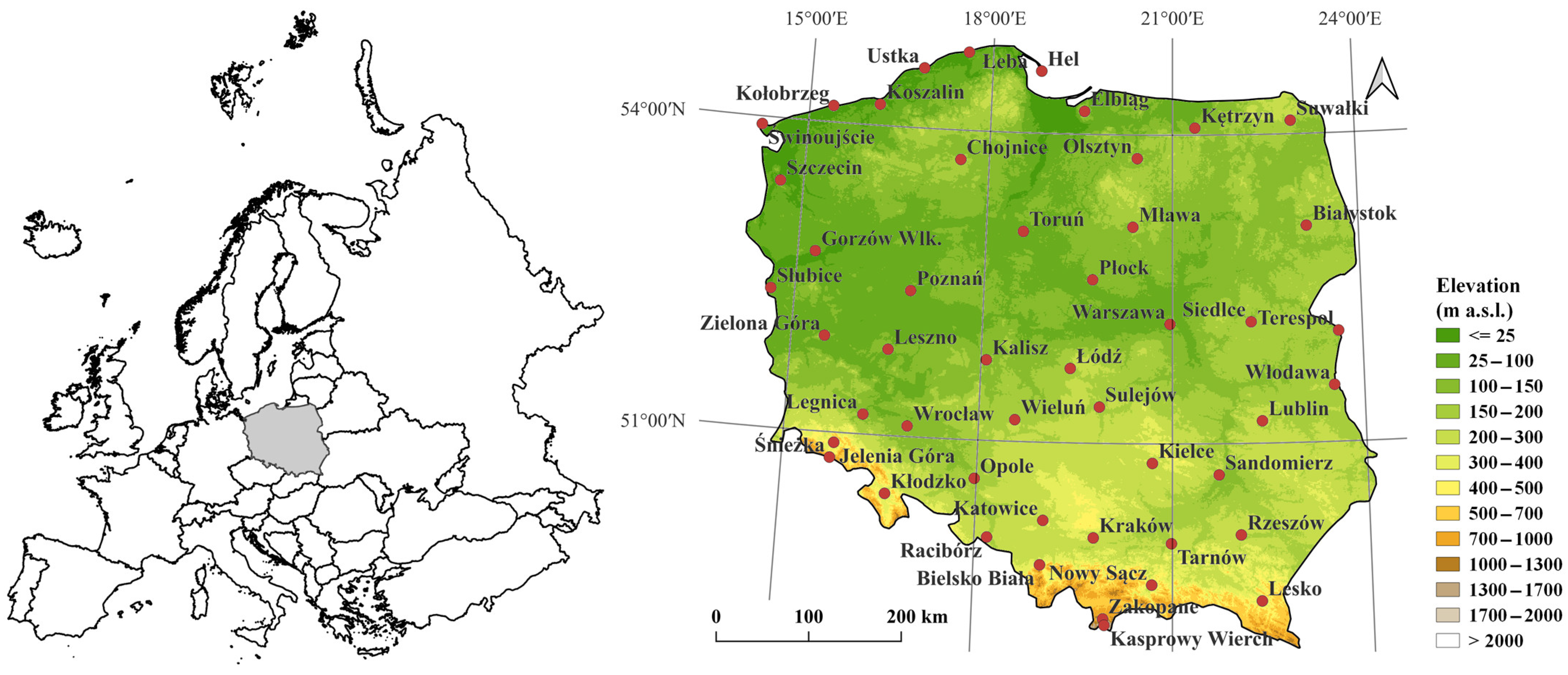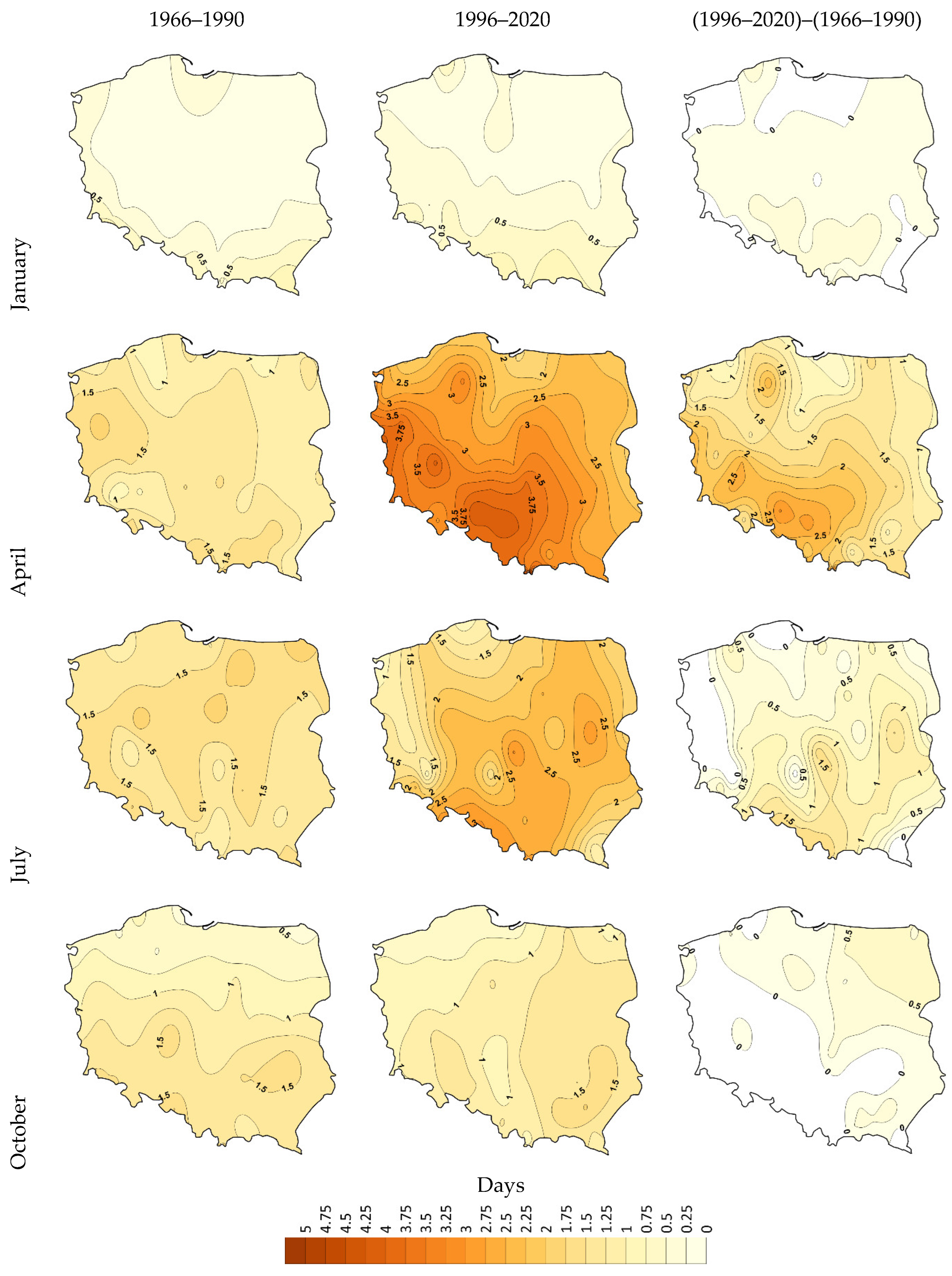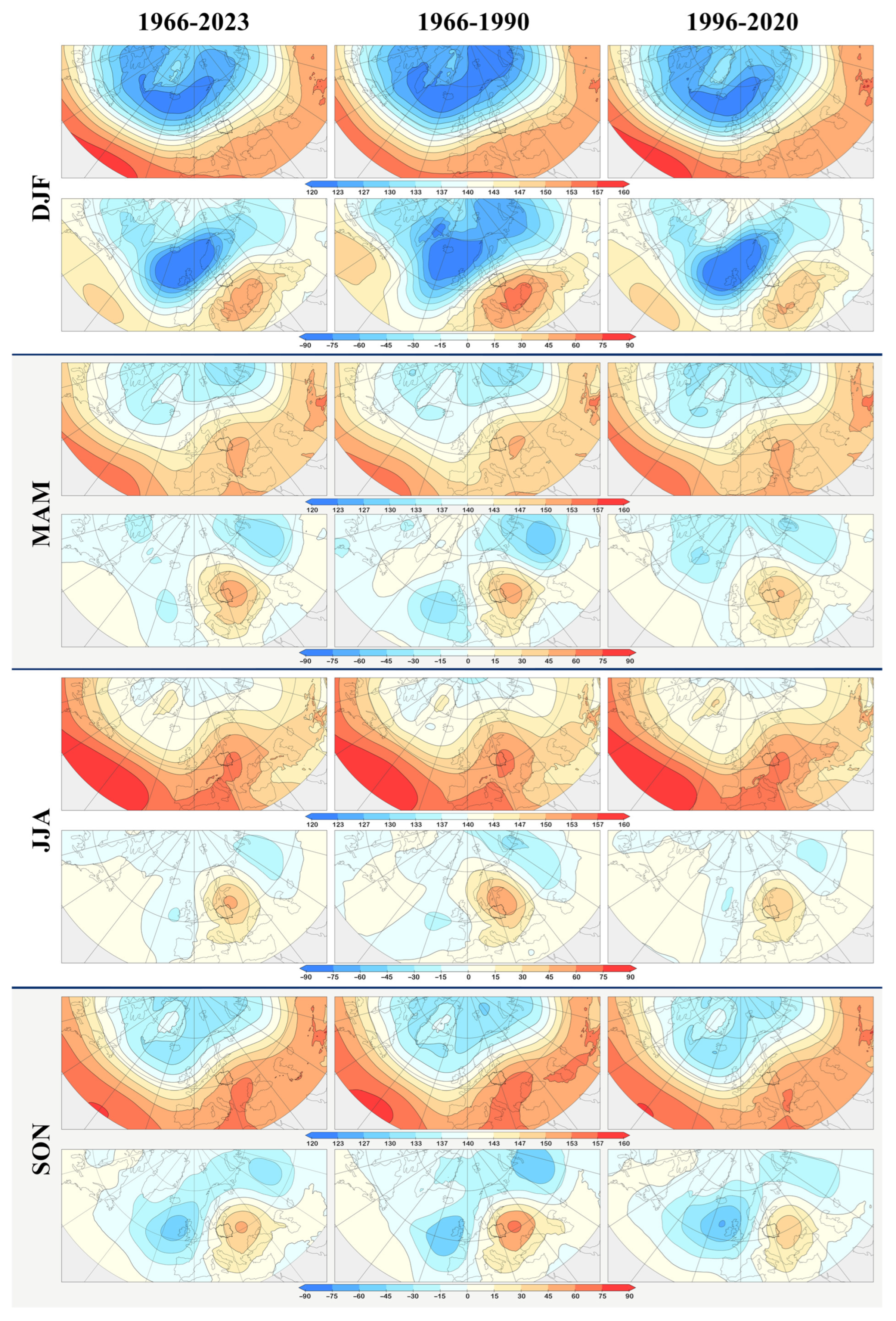Warm and Dry Compound Events in Poland
Abstract
1. Introduction
2. Materials and Methods
2.1. Warm and Dry Day Definition and Datasets
- Frequency of WD days in Poland—the monthly number of days that were warm and dry on at least one of the 48 stations in Poland.
- Station number of WD days (stWD)—the number of stations on which the day was warm and dry summed over all days of the month.
- WD intensity (WDint)—the sum of the product of temperature surplus and precipitation deficit after all warm and dry stations are totaled and are additionally summed over all the days of the month.
2.2. Large-Scale Atmospheric Circulation Data
2.3. Large-Scale Circulation Indices
2.4. Trends and Correlations
3. Results
3.1. Maximum Temperature and Its Trends
3.2. Warm-Day Frequency and Trends
3.3. Precipitation and Dry Days Frequency Trends
3.4. Warm and Dry Days
3.5. WD-Day Trends
3.6. Factors Contributing to WD-Day Occurrence
3.6.1. Effect of Warm-Day Occurrences
3.6.2. Circulation Patterns during WD Days
3.6.3. Effect of Large-Scale Circulation
4. Discussion and Conclusions
Author Contributions
Funding
Informed Consent Statement
Data Availability Statement
Acknowledgments
Conflicts of Interest
References
- Zscheischler, J.; Martius, O.; Westra, S.; Bevacqua, E.; Raymond, C.; Horton, R.M.; van den Hurk, B.; Agha Kouchak, A.; Jézéquel, A.; Mahecha, M.D.; et al. A typology of compound weather and climate events. Nat. Rev. Earth Environ. 2020, 1, 333–347. [Google Scholar] [CrossRef]
- Kautz, L.A.; Martius, O.; Pfahl, S.; Pinto, J.G.; Ramos, A.; Sousa, P.M.; Woolings, T. Atmospheric blocking and weather extremes in Euro-Atlantic sector—A review. WCD 2022, 3, 305–336. [Google Scholar] [CrossRef]
- Flanningan, M.; Stocks, B.; Turetsky, M.; Wotton, M. Impacts of climate change on fire activity and fire management in the circumboreal forest. Glob. Chang. Biol. 2009, 15, 549–560. [Google Scholar] [CrossRef]
- De Boeck, H.J.; Dreesen, F.E.; Janssens, I.A.; Nijs, I. Whole-system responses of experimental plant communities to climate extremes imposed in different seasons. New Phytol. 2011, 189, 806–817. [Google Scholar] [CrossRef] [PubMed]
- Allen, C.D.; Macalady, A.K.; Chenchouni, H.; Bachelet, D.; McDowell, N.; Vennetier, M.; Kitzberger, T.; Rigling, A.; Breshears, D.D.; Hogg, E.H.; et al. A global overview of drought and heat-induced tree mortality reveals emerging climate change risks for forests. For. Ecol. Manag. 2010, 259, 660–684. [Google Scholar] [CrossRef]
- Madden, R.A.; Williams, J. The correlation between temperature and precipitation in the United States and Europe. Mon. Weather Rev. 1978, 106, 142–147. [Google Scholar] [CrossRef]
- Trenberth, K.E.; Shea, D.J. Relationships between precipitation and surface temperature. Geophys. Res. Lett. 2005, 32, L14703. [Google Scholar] [CrossRef]
- Zscheischler, J.; Seneviratne, S.I. Dependence of drivers affects risks associated with compound events. Sci. Adv. 2017, 3, e1700263. [Google Scholar] [CrossRef]
- Baldwin, J.W.; Dessy, J.B.; Vecchi, G.A.; Oppenheimer, M. Temporally compound heat wave events and global warming: An emerging hazard. Earth’s Future 2019, 7, 411–427. [Google Scholar] [CrossRef]
- Wibig, J.; Podstawczyńska, A.; Rzepa, M.; Piotrowski, P. Heatwaves in Poland—Frequency trends and relationships with atmospheric circulation. Geogr. Pol. 2009, 82, 33–46. [Google Scholar] [CrossRef]
- Wibig, J. Heat waves in Poland in the period 1951–2015: Trends, patterns and driving factors. Meteorol. Hydrol. Water Manag. 2018, 6, 37–45. [Google Scholar] [CrossRef]
- Tomczyk, A.M.; Bednorz, E.; Półrolniczak, M.; Kolendowicz, L. Strong heat and cold waves in Poland in relation with the large-scale atmospheric circulation. Theor. Appl. Climatol. 2019, 137, 1909–1923. [Google Scholar] [CrossRef]
- Owczarek, M.; Tomczyk, A.M. Impact of atmospheric circulation on the occurrence of very strong and extreme cold stress in Poland. Quaest. Geogr. 2022, 41, 111–126. [Google Scholar] [CrossRef]
- Łabędzki, L. Actions and measures for mitigation drought and water scarcity in agriculture. J. Water Land Dev. 2016, 29, 3–10. [Google Scholar] [CrossRef]
- Somorowska, U. Changes in drought conditions in Poland over the past 60 years evaluated by the Standardized Precipitation-Evapotranspiration Index. Acta Geophys. 2016, 64, 2530–2549. [Google Scholar] [CrossRef]
- Pińskwar, I. Complex Changes of Extreme Precipitation in the Warming Climate of Poland. Int. J. Climatol. 2022, 42, 817–833. [Google Scholar] [CrossRef]
- Jaagus, J.; Aasa, A.; Aniskevich, S.; Boincean, B.; Bojariu, R.; Briede, A.; Danilovich, I.; Castro, R.D.; Dumitrescu, A.; Labuda, M.; et al. Long-term changes in drought indices in eastern and central Europe. Int. J. Climatol. 2022, 42, 225–249. [Google Scholar] [CrossRef]
- Wibig, J. Dry and Wet Spells in Poland in the Period 1966–2023. Water 2024, 16, 1344. [Google Scholar] [CrossRef]
- Hersbach, H.; Bell, B.; Berrisford, P.; Hirahara, S.; Horanyi, A.; Muñoz-Sabater, J.; Nicolas, J.; Peubey, C.; Radu, R.; Schepers, D.; et al. The ERA5 global reanalysis. Q. J. Roy. 2020, 146, 1999–2049. [Google Scholar] [CrossRef]
- Hanna, E.; Cropper, T.E.; Hall, R.J.; Cappelen, J. Greenland Blocking Index 1851–2015: A regional climate change signal. Int. J. Climatol. 2016, 36, 4847–4861. [Google Scholar] [CrossRef]
- Enfield, D.B.; Mestas-Nunez, A.M.; Trimble, P.J. The Atlantic Multidecadal Oscillation and its relationship to rainfall and river flows in the continental U.S. Geophys. Res. Lett. 2001, 28, 2077–2080. [Google Scholar] [CrossRef]
- Barnston, A.G.; Livezey, R.E. Classification, Seasonality and Persistence of Low-Frequency Atmospheric Circulation Patterns. Mon. Weather Rev. 1987, 115, 1083–1126. [Google Scholar] [CrossRef]
- Sen, P.K. Estimates of the regression coefficient based on Kendall’s tau. J. Am. Stat. Assoc. 1968, 63, 1379–1389. [Google Scholar] [CrossRef]
- Theil, H. A rank-invariant method of linear and polynomial regression analysis. In Henri Theil’s Contributions to Economics and Econometrics, Advanved Studies in Theoretical and Applied Econometrics; Raj, B., Koerts, J., Eds.; Springer: Dordrecht, The Netherlands, 1992; Volume 23, pp. 345–381. [Google Scholar]
- Mann, H.B. Nonparametric tests against trend. Econometrica 1945, 13, 245–259. [Google Scholar] [CrossRef]
- Kendall, M.G. The treatment of ties in ranking problems. Biometrika 1945, 33, 239–245. [Google Scholar] [CrossRef]
- Climate Monitoring Bulletin of Poland, Year 2023, IMWM-NRI. 2024. Available online: https://klimat.imgw.pl/img/biuletyn-monitoring/2023/monitoring_12_2023.pdf (accessed on 10 July 2024).
- Ustrunul, A.; Wypych, A.; Czekierda, D. Air Temperature Change. In Climate Change in Poland: Past, Present, Future; Falarz, M., Ed.; Springer Climate: Cham, Switzerland, 2021; pp. 331–348. [Google Scholar]
- Sulikowska, A.; Wypych, A. Seasonal variability of trends in regional hot and warm temperature extremes in Europe. Atmosphere 2021, 12, 612. [Google Scholar] [CrossRef]
- Tomczyk, A.M.; Piotrowski, P.; Bednorz, E. Warm spells in Northern Europe in relation to atmospheric circulation. Theor. Appl. Climatol. 2017, 128, 623–634. [Google Scholar] [CrossRef]
- Wibig, J. Hot days and heat waves in Poland in the period 1951-2019 and the circulation factors favoring the most extreme of them. Atmosphere 2021, 12, 340. [Google Scholar] [CrossRef]
- Łupikasza, E.B. Seasonal patterns and consistency of extreme precipitation trends in Europe, December 1950 to February 2008. Clim. Res. 2017, 72, 217–237. [Google Scholar] [CrossRef][Green Version]
- Szwed, I. Variability of precipitation in Poland under climate change. Theor Appl Climatol. 2019, 135, 1003–1015. [Google Scholar] [CrossRef]
- Łupikasza, E.; Małarzewski, Ł. Precipitation Change. In Climate Change in Poland: Past, Present, Future; Falarz, M., Ed.; Springer Climate: Cham, Switzerland, 2021; pp. 349–373. [Google Scholar]
- Meehl, G.; Stocker, T.F.; Collins, W.D.; Friedlingstein, P.; Gaye, A.T.; Gregory, J.M.; Kitoh, A.; Knutti, R.; Murphy, J.M.; Noda, A.; et al. Global climate projections. In Climate Change 2007: The Physical Science Basis; Contribution of Working Group I to the Fourth Assessment Report of the Intergovernmental Panel on Climate Change; Solomon, S., Qin, D., Manning, M., Chen, Z., Marquis, M., Averyt, K.B., Tignor, M., Miller, H.L., Eds.; Cambridge University Press: Cambridge, UK; New York, NY, USA, 2007. [Google Scholar]
- Ye, H.C. Changes in frequency of precipitation types associated with surface air temperature over northern Eurasia during 1936–1990. J. Clim. 2008, 21, 5807–5819. [Google Scholar] [CrossRef]
- Ye, H.C.; Fetzer, E.J.; Behrangi, A.; Wong, S.; Lambrigtsen, B.H.; Wang, C.Y.; Cohen, J.; Gamelin, B.L. Increasing daily precipitation intensity associated with warmer air temperatures over Northern Eurasia. J. Clim. 2016, 29, 623–636. [Google Scholar] [CrossRef]
- Lenderink, G.; van Meijgaard, E. Increase in hourly precipitation extremes beyond expectations from temperature changes. Nat. Geosci. 2008, 1, 511–514. [Google Scholar] [CrossRef]
- Wibig, J.; Piotrowski, P. Impact of the air temperature and atmospheric circulation on extreme precipitation in Poland. Int. J. Climatol. 2018, 38, 4533–4549. [Google Scholar] [CrossRef]
- Bastos, A.; Sippel, S.; Frank, D.; Mahecha, M.D.; Zaehle, S.; Zscheischler, J.; Reichstein, M. A joint framework for studying compound ecoclimatic events. Nat. Rev. Earth Environ. 2023, 4, 333–350. [Google Scholar] [CrossRef]











| Full Name | Abbrev. | Source | Ref. |
|---|---|---|---|
| Greenland Blocking Index | GBI | psl.noaa.gov/gcos_wgsp/Timeseries/Data/gbi.mon.data (assessed on 10 July 2024) | [20] |
| Atlantic Multidecadal Oscillations | AMO | www1.ncdc.noaa.gov/pub/data/cmb/ersst/v5/index/ersst.v5.amo.dat (assessed on 10 July 2024) | [21] |
| Arctic Oscillation | AO | cpc.ncep.noaa.gov/products/precip/CWlink/daily_ao_index/monthly.ao.index.b50.current.ascii (assessed on 10 July 2024) | - |
| North Atlantic Oscillation | NAO | https://ftp.cpc.ncep.noaa.gov/wd52dg/data/indices/tele_index.nh (assessed on 10 July 2024) | [22] |
| Scandinavian Index | SCAND | https://ftp.cpc.ncep.noaa.gov/wd52dg/data/indices/tele_index.nh (assessed on 10 July 2024) | [22] |
| East Atlantic Index | EA | https://ftp.cpc.ncep.noaa.gov/wd52dg/data/indices/tele_index.nh (assessed on 10 July 2024) | [22] |
| Eastern Europe/Western Russia | EAWR | https://ftp.cpc.ncep.noaa.gov/wd52dg/data/indices/tele_index.nh (assessed on 10 July 2024) | [22] |
| Month/Season | Number of Days, Days dec−1 | Number of Station Days, Days dec−1 | Intensity, mm deg dec−1 |
|---|---|---|---|
| January | 0.23 | 0.59 | −0.75 |
| February | 0.00 | 0.40 | −4.24 |
| March | 0.49 | 2.00 | −3.79 |
| April | 1.35 | 12.08 | −105.36 |
| May | 0.00 | 0.83 | −4.38 |
| June | 1.05 | 10.00 | −236.09 |
| July | 1.29 | 6.13 | −105.80 |
| August | 1.62 | 7.50 | −95.12 |
| September | 0.73 | 4.00 | −57.55 |
| October | 0.44 | 1.67 | −10.00 |
| November | 0.93 | 4.72 | −27.98 |
| December | 1.00 | 4.44 | −22.95 |
| Spring | 2.11 | 25.68 | −240.04 |
| Summer | 3.85 | 29.14 | −716.76 |
| Autumn | 2.44 | 16.38 | −214.62 |
| Winter | 1.91 | 10.58 | −104.16 |
| Year | 10.00 | 97.04 | −1871.24 |
| Period | Probability | January | February | March | April | May | June | July | August | September | October | November | December |
|---|---|---|---|---|---|---|---|---|---|---|---|---|---|
| 1966–2023 | Simpl. | 21.6 | 20.2 | 22.5 | 26.5 | 20.8 | 25.9 | 25.0 | 24.0 | 27.5 | 25.5 | 24.0 | 27.3 |
| Cond. | 11.4 | 15.7 | 27.4 | 41.9 | 31.5 | 40.2 | 43.9 | 41.8 | 52.9 | 41.4 | 28.9 | 25.1 | |
| 1966–1990 | Simpl. | 24.4 | 21.1 | 24.9 | 25.1 | 20.1 | 21.4 | 25.4 | 22.5 | 27.2 | 27.3 | 22.9 | 22.4 |
| Cond. | 15.9 | 18.8 | 26.5 | 39.1 | 31.1 | 37.3 | 52.5 | 39.3 | 54.5 | 51.2 | 29.4 | 15.2 | |
| 1996–2020 | Simpl. | 21.4 | 21.4 | 19.1 | 31.4 | 19.5 | 27.2 | 21.8 | 23.2 | 29.6 | 22.6 | 26.6 | 32.1 |
| Cond. | 11.4 | 16.2 | 25.7 | 44.9 | 28.9 | 37.4 | 37.2 | 41.0 | 56.2 | 38.6 | 29.8 | 35.8 |
| Indices | AMO | AO | NAO | EA | EAWR | SCAND | GBI |
|---|---|---|---|---|---|---|---|
| January | 0.115 | 0.276 | 0.284 | 0.550 | −0.143 | 0.048 | −0.327 |
| February | 0.138 | 0.441 | 0.301 | 0.381 | 0.212 | −0.194 | −0.317 |
| March | −0.016 | 0.402 | 0.232 | 0.377 | 0.249 | 0.009 | −0.347 |
| April | 0.181 | 0.142 | 0.168 | 0.260 | 0.140 | 0.237 | 0.024 |
| May | 0.058 | 0.228 | 0.198 | 0.285 | 0.041 | 0.244 | −0.165 |
| June | 0.284 | 0.192 | 0.270 | 0.229 | −0.045 | −0.050 | −0.179 |
| July | 0.349 | 0.210 | 0.075 | 0.327 | 0.071 | −0.008 | 0.036 |
| August | 0.289 | 0324 | 0.252 | 0.414 | −0.006 | −0.210 | −0.187 |
| September | 0.198 | 0.520 | 0.264 | 0.507 | −0.145 | 0.010 | −0.249 |
| October | 0.177 | 0.130 | 0.056 | 0.333 | 0.015 | 0.302 | −0.103 |
| November | 0.185 | 0.123 | 0.220 | 0.346 | 0.131 | 0.284 | −0.146 |
| December | 0.259 | 0.314 | 0.482 | 0.369 | −0.040 | −0.068 | −0.289 |
Disclaimer/Publisher’s Note: The statements, opinions and data contained in all publications are solely those of the individual author(s) and contributor(s) and not of MDPI and/or the editor(s). MDPI and/or the editor(s) disclaim responsibility for any injury to people or property resulting from any ideas, methods, instructions or products referred to in the content. |
© 2024 by the authors. Licensee MDPI, Basel, Switzerland. This article is an open access article distributed under the terms and conditions of the Creative Commons Attribution (CC BY) license (https://creativecommons.org/licenses/by/4.0/).
Share and Cite
Wibig, J.; Jędruszkiewicz, J. Warm and Dry Compound Events in Poland. Atmosphere 2024, 15, 1019. https://doi.org/10.3390/atmos15091019
Wibig J, Jędruszkiewicz J. Warm and Dry Compound Events in Poland. Atmosphere. 2024; 15(9):1019. https://doi.org/10.3390/atmos15091019
Chicago/Turabian StyleWibig, Joanna, and Joanna Jędruszkiewicz. 2024. "Warm and Dry Compound Events in Poland" Atmosphere 15, no. 9: 1019. https://doi.org/10.3390/atmos15091019
APA StyleWibig, J., & Jędruszkiewicz, J. (2024). Warm and Dry Compound Events in Poland. Atmosphere, 15(9), 1019. https://doi.org/10.3390/atmos15091019






